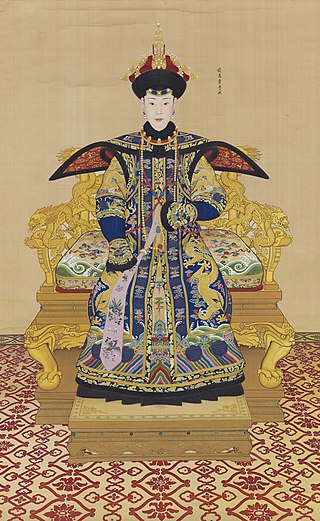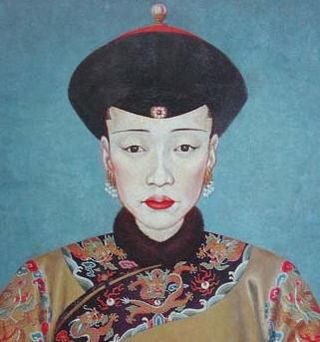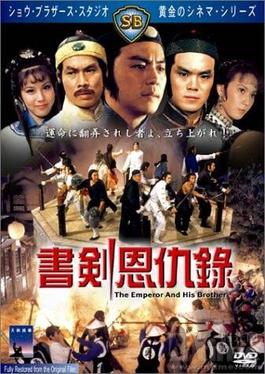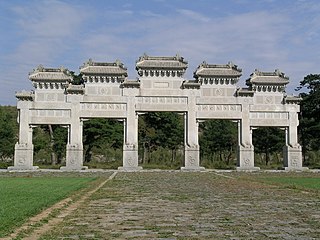Related Research Articles

The Daoguang Emperor, also known by his temple name Emperor Xuanzong of Qing, personal name Mianning, was the seventh emperor of the Qing dynasty, and the sixth Qing emperor to rule over China proper. His reign was marked by "external disaster and internal rebellion". These include the First Opium War and the beginning of the Taiping Rebellion which nearly brought down the dynasty. The historian Jonathan Spence characterizes the Daoguang Emperor as a "well meaning but ineffective man" who promoted officials who "presented a purist view even if they had nothing to say about the domestic and foreign problems surrounding the dynasty".

The Jiaqing Emperor, also known by his temple name Emperor Renzong of Qing, personal name Yongyan, was the sixth emperor of the Qing dynasty and the fifth Qing emperor to rule over China proper. He was the 15th son of the Qianlong Emperor. During his reign, he prosecuted Heshen, the corrupt favorite of his father and attempted to restore order within the empire while curbing the smuggling of opium into China. Assessments of his reign are mixed, either seen as the "beginning of the end" of the Qing dynasty, or as a period of moderate reform that presaged the intellectual movements of the 1860s.

The Qianlong Emperor, also known by his temple name Emperor Gaozong of Qing, personal name Hongli, was the fifth emperor of the Qing dynasty and the fourth Qing emperor to rule over China proper. He reigned officially from 1735 until his abdication in 1796, but retained ultimate power subsequently until his death in 1799, making him one of the longest-reigning monarchs in history as well as one of the longest-lived.

The House of Aisin-Gioro is a Manchu clan that ruled the Later Jin dynasty (1616–1636), the Qing dynasty (1636–1912), and Manchukuo (1932–1945) in the history of China. Under the Ming dynasty, members of the Aisin Gioro clan served as chiefs of the Jianzhou Jurchens, one of the three major Jurchen tribes at this time. Qing bannermen passed through the gates of the Great Wall in 1644, and eventually conquered the short-lived Shun dynasty, Xi dynasty and Southern Ming dynasty. After gaining total control of China proper, the Qing dynasty later expanded into other adjacent regions, including Xinjiang, Tibet, Outer Mongolia, and Taiwan. The dynasty reached its zenith during the High Qing era and under the Qianlong Emperor, who reigned from 1735 to 1796. This reign was followed by a century of gradual decline.

The Niohuru were a prominent Manchu clan during the Qing dynasty. The clan had inhabited the Changbai Mountains since as early as the Liao dynasty. The clan was well known during the Qing dynasty for producing a variety of consorts of all ranks for emperors, several of whom went on to become mothers to reigning emperors. Prominent people who belonged or trace heritage to the Niohuru clan including famed Manchu warrior Eidu, his son the high official Ebilun, the Empress Dowager Ci'an, the infamous corrupt official Heshen, the contemporary concert pianist Lang Lang and Lang Tsuyun, Taiwanese TV, movie and stage actress, singer and producer.

Empress Xiaoherui, of the Manchu Bordered Yellow Banner Niohuru clan, was a posthumous name bestowed to the wife and second empress consort of Yongyan, the Jiaqing Emperor. She was empress consort of Qing from 1801 until her husband's death in 1820, after which she was honoured as Empress Dowager Gongci during the reign of her step-son, Mianning, the Daoguang Emperor. She was the longest-serving empress consort in Qing history.

Empress Xiaoshurui (孝淑睿皇后), of the Manchu Plain White Banner Hitara clan (喜塔臘氏) was a posthumous name bestowed to the wife and first empress consort of Yongyan, the Jiaqing Emperor. She was empress consort of Qing from 1796 until her death in 1797, having been empress for barely a year.

The Grand Council or Junji Chu, officially the Banli Junji Shiwu Chu, was an important policy-making body of China during the Qing dynasty. It was established in 1733 by the Yongzheng Emperor. The council was originally in charge of military affairs, but gradually attained a more important role and eventually attained the role of a privy council, eclipsing the Grand Secretariat in function and importance, which is why it has become known as the "Grand Council" in English.

Imperial Noble Consort Chunhui, of the Han Chinese Plain White Banner Su clan, was a consort of the Qianlong Emperor. She was two years his junior.

Empress Xiaoshencheng, of the Manchu Bordered Yellow Banner Tunggiya clan, was a posthumous name bestowed on the wife and first empress consort of Mianning, the Daoguang Emperor. She was empress consort of Qing from 1822 until her death in 1833.

Noble Consort Wan, of the Han Chinese Chen clan, was a consort of the Qianlong Emperor. She was five years his junior.

Consort He, of the Manchu Plain White Banner Hoifa Nara clan, was a consort of the Daoguang Emperor.

The Emperor and His Brother is a 1981 Hong Kong wuxia film based on Louis Cha's novel The Book and the Sword. Produced by the Shaw Brothers Studio, the film was directed by Chor Yuen and starred Ti Lung, Jason Pai and Lo Lieh in the leading roles.

The Western Qing tombs are located some 140 km (87 mi) southwest of Beijing in Yi County, Hebei Province. They constitute a necropolis that incorporates four royal mausoleums where seventy-eight royal members are buried. These include four emperors of the Qing dynasty and their empresses, imperial concubines, princes and princesses, as well as other royal servants.
Empress Xiao may refer to:
The Deliberative Council of Princes and Ministers, also known as the Council of Princes and High Officials and Assembly of Princes and High Officials, or simply as the Deliberative Council, was an advisory body for the emperors of the early Qing dynasty (1644–1912). Derived from informal deliberative groups created by Nurhaci (1559–1626) in the 1610s and early 1620s, the Council was formally established by his son and successor Hong Taiji (1592–1643) in 1626 and expanded in 1637. Staffed mainly by Manchu dignitaries, this aristocratic institution served as the chief source of advice on military matters for Hong Taiji and the Shunzhi and Kangxi emperors. It was particularly powerful during the regencies of Dorgon (1643–1650) and Oboi (1661–1669), who used it to enhance their personal influence.
The history of the Qing dynasty began in the first half of the 17th century, when the Qing dynasty was established and became the last imperial dynasty of China, succeeding the Ming dynasty (1368–1644). The Manchu leader Hong Taiji renamed the Later Jin established by his father Nurhaci to "Great Qing" in 1636, sometimes referred to as the Predynastic Qing in historiography. By 1644 the Shunzhi Emperor and his prince regent seized control of the Ming capital Beijing, and the year 1644 is generally considered the start of the dynasty's rule. The Qing dynasty lasted until 1912, when Puyi abdicated the throne in response to the 1911 Revolution. As the final imperial dynasty in Chinese history, the Qing dynasty reached heights of power unlike any of the Chinese dynasties which preceded it, engaging in large-scale territorial expansion which ended with embarrassing defeat and humiliation to the foreign powers whom they believe to be inferior to them. The Qing dynasty's inability to successfully counter Western and Japanese imperialism ultimately led to its downfall, and the instability which emerged in China during the final years of the dynasty ultimately paved the way for the Warlord Era.

The imperial hunt of the Qing dynasty was an annual rite of the emperors of China's Qing dynasty. It was first organized in 1681 by the Kangxi Emperor at the imperial hunting grounds at Mulan. Starting in 1683 the event was held annually at Mulan during the autumn, lasting up to a month. The Qing dynasty hunt was a synthesis of earlier Han and Inner Asian hunting traditions, particularly those of the Manchus and Mongols. The emperor himself participated in the hunt, along with thousands of soldiers, imperial family members, and government officials.
Consort Xin, of the Manchu Bordered White Banner Liugiya clan, was a consort of Jiaqing Emperor.
References
- ↑ Yesasia.com. "Yesasia.com." 滿清十三皇朝. Retrieved on 2010-12-27.